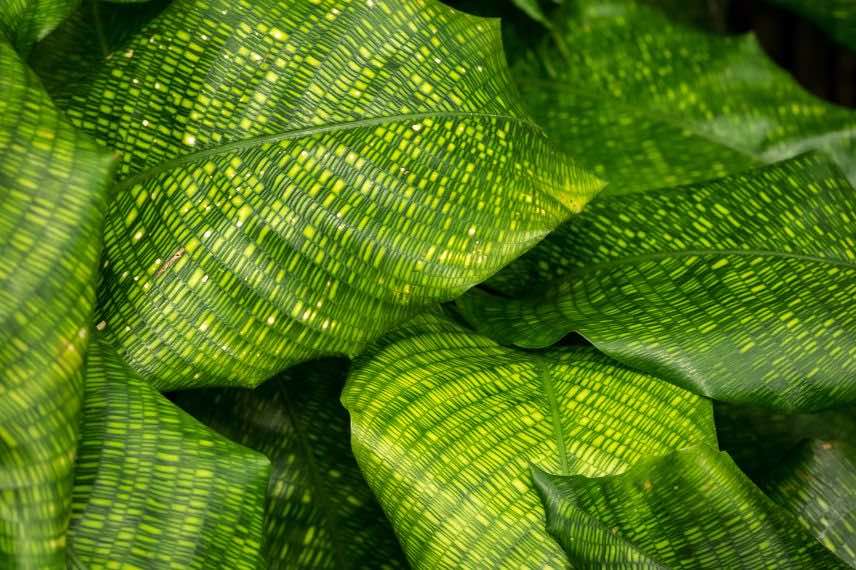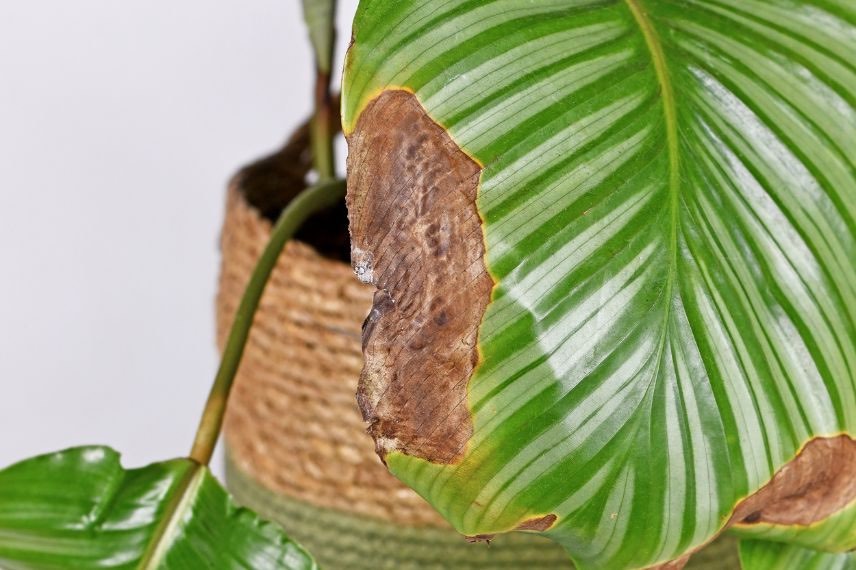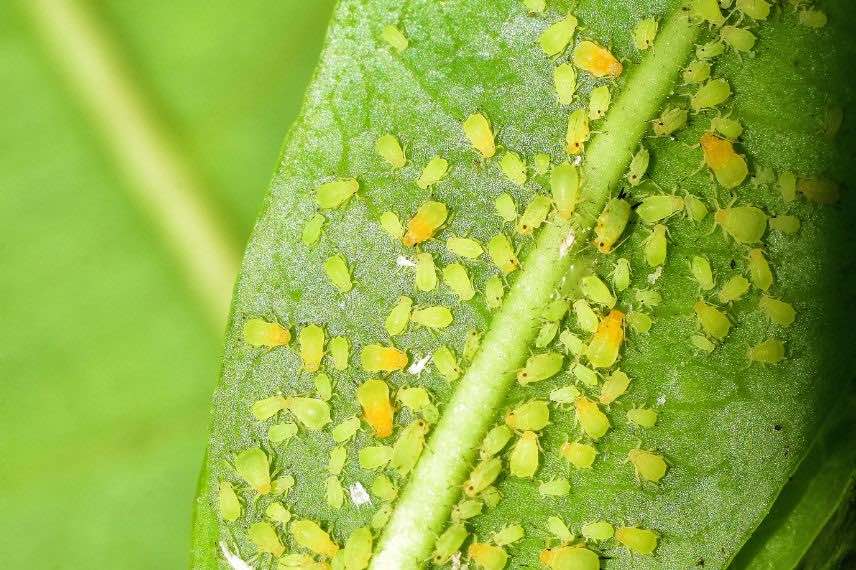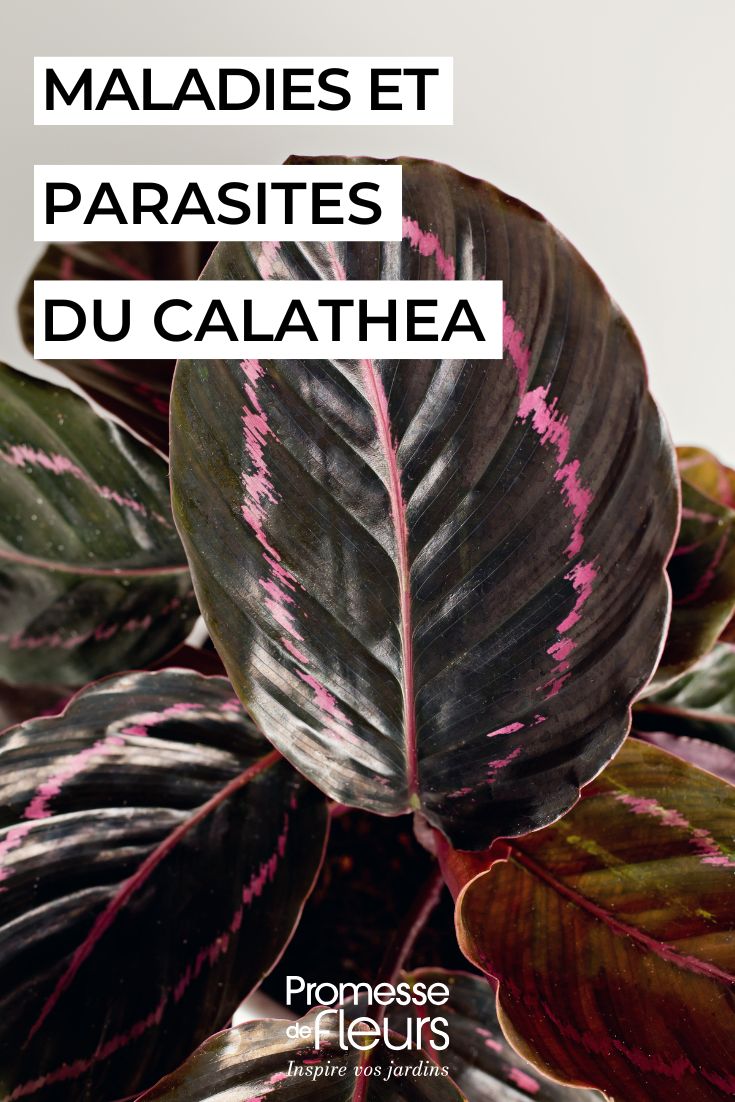
Calathea: Diseases, Common Problems and Parasites
Identify, treat, prevent
Contents
The Calathea is a tropical houseplant prized for its decorative foliage with unique patterns and varied colours, hence its common name Peacock Plant. Native to the humid forests of South America, it requires specific conditions to thrive: high humidity, appropriate watering and soil, and filtered light.
The Calathea (now classified in the genus Geoppertia but still less commonly known by this name) is a sensitive plant that can be affected by various health issues, including fungal and bacterial diseases as well as parasitic attacks. Improper care, an environment that’s too dry or excessive moisture can lead to foliar spots, browned leaves or infestations of harmful insects.
Discover our essential advice for understanding the causes of the most common diseases and infestations, quickly identifying symptoms and applying the appropriate solutions.

The beautiful leaves of Calathea (geoppertia) ‘Network’
Common Diseases and Problems of Calathea
Root Rot
This disease is mainly caused by overwatering or poorly draining soil that prevents oxygen from reaching the roots. When roots are waterlogged, they eventually become necrotic and can no longer absorb essential nutrients for the plant.
The first symptoms often appear on the foliage: leaves turn yellow, become limp, and droop. Upon inspecting the roots, they may appear dark brown or black, sometimes slimy, and emit an unpleasant odour.
To prevent this issue:
- It is essential to use well-draining soil suitable for Calatheas. Ideally, it should consist of a light indoor plant compost made from high-quality turf, supplemented with coconut coir and perlite.
- A pot with drainage holes is essential to allow excess water to escape after each watering.
- Empty the saucer or decorative pot of any residual water.
If rot is detected, act quickly by repotting the plant in fresh, dry soil after cutting away affected roots with sterilised tools.
Leaf Spots
Leaf spots are typically caused by bacterial or fungal infections, encouraged by excessive humidity and poor air circulation around the plant. These spots may vary in colour depending on the pathogen involved:
- Brown to black spots, often surrounded by a yellow halo, indicate a bacterial infection.
- Grey to black spots, sometimes slightly powdery, suggest a fungal attack.
Excessive moisture, particularly when water lingers on leaves after misting, promotes the development of these diseases.
To limit spread, affected leaves should be cut off and discarded (do not leave them on the soil, as they could contaminate other parts of the plant).
Good air circulation is crucial to prevent infections: place the Calathea in a well-ventilated spot, but avoid cold draughts that could weaken the plant.
Curling Leaves
The Calathea is particularly sensitive to humidity fluctuations and growing conditions. When its leaves curl inwards, this often signals low humidity or water stress. This reaction is a natural defence mechanism to reduce water loss.
The main causes include:
- Overly dry air, due to heating in winter or exposure to air conditioning.
- Underwatering, preventing the plant from maintaining sufficient hydration.
- Temperature shock, such as suddenly moving the plant from a humid to a drier environment.
To remedy this, increase ambient humidity by regularly misting the foliage with non-calcareous water or placing a humidifier nearby.
Regarding watering, Calatheas prefer slightly moist soil at all times, but never waterlogged. Use filtered or rainwater, as tap water—too high in lime—can damage the plant over time.
Brown Leaf Edges
Another common issue with Calatheas is browning leaf tips. This can result from several environmental factors:
- Water high in minerals: the accumulation of lime and chlorine in tap water can cause leaf burn.
- Low ambient humidity: as a tropical plant, Calatheas suffer in dry air, leading to dried leaf edges.
- Excessive light exposure: Calatheas thrive in moderate light—avoid direct sunlight entirely.
To prevent this, water the plant with filtered, demineralised, or rainwater. Increasing humidity with a humidifier is also beneficial.

Calatheas are quite prone to developing damaged leaves with brown edges
Read also
Calathea : varieties, growing and careCalathea Pests
Parasites are one of the main issues affecting Calathea, especially when growing conditions are suboptimal. Excessively dry air, lack of maintenance, or poorly drained compost can encourage their appearance. Several insects and mites attack this plant by feeding on its sap, leading to general weakening and damage to the foliage.
Spider Mites (Red Spider Mites)
These microscopic mites appear mainly when the air is too dry. They settle under the leaves, causing discolouration and gradual yellowing of the foliage. In advanced stages, fine webs may be visible between stems and the undersides of leaves.
Low humidity and poor air circulation encourage their proliferation, particularly in winter with indoor heating.
Solutions:
- Start by rinsing the foliage thoroughly with water directly in the shower
- Increase ambient humidity by misting the leaves or using a humidifier
- Regularly wipe the leaves with a damp cloth to limit their spread
- Apply a solution based on black soap and rosemary essential oil in case of infestation
- Introduce beneficial predators like Phytoseiulus persimilis, a mite that preys on spider mites
→ Read our detailed article on spider mites to learn more about treatments.
Mealybugs
Mealybugs are small white insects covered in a waxy layer that attach to stems and leaf undersides. They weaken the plant by sucking its sap, leading to yellowing and stunted growth. Their presence often results in honeydew, a sticky substance that can encourage sooty mould. They are visible to the naked eye as small white cottony clusters.
Solutions:
- Isolate the plant to prevent spread.
- Remove mealybugs with a cotton bud dipped in 70% alcohol.
- Apply a diluted black soap solution with 1 teaspoon of the same alcohol and rapeseed oil for a natural treatment.
Thrips
Thrips are tiny insects, often black or brown, that feed on plant sap. They leave silvery or translucent marks on leaves, which eventually become deformed. Their rapid reproduction cycle makes them difficult to eradicate. They can cause significant damage and eventually kill the plant through prolonged weakening.
Dry, warm air encourages their development, and an already weakened plant is more vulnerable.
Solutions:
- Isolate the plant at the first signs of infestation.
- Spray a neem oil solution to limit their spread.
- Introduce natural predators like Orius laevigatus, which feed on thrips.
- Place blue sticky traps to monitor and reduce thrip populations.
Aphids
Aphids mainly attack young shoots of Calathea, where they cluster in colonies. They weaken the plant by sucking its sap, causing deformed leaves and stunted growth. Their presence also leads to sticky deposits that encourage sooty mould.
Excessive nitrogen fertiliser stimulates plant growth, which can attract aphids. A weakened plant is also more susceptible to attacks.
Solutions:
- Wash the plant with lukewarm water to manually remove aphids.
- Spray a mixture of water and black soap for a natural treatment.
- For severe infestations, apply an organic insecticide based on pyrethrum.

Aphids can weaken Calathea; they are visible to the naked eye and settle on stems and leaf undersides
Proper Care for Calathea to Prevent Diseases
The Calathea is a tropical plant that thrives in a humid atmosphere. It is recommended to mist the foliage regularly with non-calcareous water or use a humidifier.
It is also important to avoid draughts and sudden temperature changes, which can stress the plant.
The Calathea needs a slightly moist substrate at all times, but without excess.
Tap water, often hard and chlorinated, can lead to a harmful build-up of minerals for Calatheas.
The Calathea prefers filtered light. However, avoid placing the plant too far from a light source to prevent stunted growth.
- Subscribe!
- Contents
































Comments